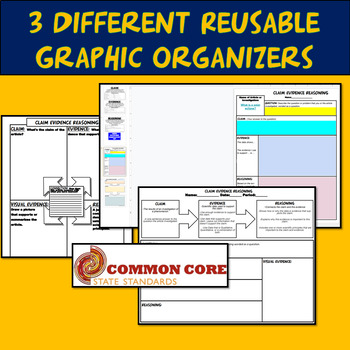Climate Change Reading Worksheet Claim Evidence Reasoning Digital Resource
- Zip
Description
Students learn what Climate Change is, how do we know it’s real, how it’s changing climate, what the impacts are and can we reverse it through a C.E.R. (Claim Evidence Reasoning) graphic organizer. This is great for getting your students to explain phenomena in a meaningful way and it allows you as the instructor to adequately assess their understanding of concepts. The students figure out what the "Claim" is in the article, they then use data that supports the claim in the "Evidence" section, draw visual evidence and then explain why the evidence supports the claim in the "Reasoning" section.
The article has the following concepts:
Climate change
Climate models
Impacts of Climate change
Can We Reverse Climate change?
Ocean Acidification
Global average pH of ocean surface
Human activity
Industrial Revolution
Cores drilled from ocean sediments
Atmospheric gases
Greenhouse Gases
Carbon Dioxide
Oxygen
Methane
Molecules
Take a look at my CER Mega bundle!
This is great for a current event, sub plan, homework, critical thinking, scaffolding and/or reinforcement of concepts!
You get a CER graphic organizer, an editable key, the article, tips for CER and the link to the website in the article.
NGSS Standards:
Middle School:
ESS3.C: Human Impacts on Earth Systems: Human activities have significantly altered the biosphere, sometimes damaging or destroying natural habitats and causing the extinction of other species. But changes to Earth’s environments can have different impacts (negative and positive) for different living things.(MS-ESS3-3)
High School: Changes in the atmosphere due to human activity have increased carbon dioxide concentrations and thus affect climate. (HS-ESS2-4)
ESS3.D: Global Climate Change: Though the magnitudes of human impacts are greater than they have ever been, so too are human abilities to model, predict, and manage current and future impacts.(HS-ESS3-5)
SEP's
Asking Questions and Defining Problem:
Students at any grade level should be able to ask questions of each other about the texts they read, the features of the phenomena they observe, and the conclusions they draw from their models or scientific investigations.
Engaging in Argument from Evidence:
In 9–12 builds on K–8 experiences and progresses to using appropriate and sufficient evidence and scientific reasoning to defend and critique claims and explanations about the natural and designed world(s). Arguments may also come from current scientific or historical episodes in science.
Construct an explanation based on valid and reliable evidence obtained from a variety of sources (including students' own investigations, models, theories, simulations, peer review) and the assumption that theories and laws that describe the natural world operate today as they did in the past and will continue to do so in the future. (HS-ESS1-2)
CCC's
CCC1: Patterns
Observed patterns of forms and events guide organization and classification, and they prompt questions about relationships and the factors that influence them.
Systems and System Models
Models (e.g., physical, mathematical, computer models) can be used to simulate systems and interactions—including energy, matter, and information flows—within and between systems at different scales. (HS-LS2-5)
Energy and Matter
Changes of energy and matter in a system can be described in terms of energy and matter flows into, out of, and within that system. (HS-LS1-5), (HS-LS1-6)
Energy cannot be created or destroyed—it only moves between one place and another place, between objects and/or fields, or between systems. (HS-LS1-7), (HS-LS2-4)
Energy drives the cycling of matter within and between systems. (HS-LS2-3)
Cause and Effect: Empirical evidence is required to differentiate between cause and correlation and make claims about specific causes and effects.(HS-ESS2-4)
Stability and Change: Change and rates of change can be quantified and modeled over very short or very long periods of time. Some system changes are irreversible.(HS-ESS3-5)
TERMS OF USE
• All rights reserved by Williams Hands On Science, Inc.
• This product is to be used by the original purchaser only.
• Intended for classroom and personal use only.
• Copying for more than one teacher, classroom, department, school, or school system is prohibited.
• This product may not be distributed or displayed digitally for public view.
• Failure to comply is a copyright infringement and a violation of the Digital Millennium Copyright Act (DMCA).
If there are any errors or questions, please contact me through TpT or email me at:
williamshandsonscience@gmail.com
Thank you for taking a look!
Please follow me on TpT for new products and check me out on Instagram for my products in action!
https://www.instagram.com/williams_hands_on_science/
Related Products
⭐ Claim Evidence Reasoning (CER): Autumn Equinox Can Fall on Different Days
⭐ Claim Evidence Reasoning Growing Bundle
⭐ NGSS Black Holes & Galaxies Claim Evidence Reasoning Graphic Organizer
⭐ NGSS Claim Evidence Reasoning (CER) Big Bang Graphic Organizer
⭐ NGSS Claim Evidence Reasoning (CER) High Frequency Sound Waves
⭐ NGSS Claim Evidence Reasoning The Mysterious Planet Nine Solar System Astronomy
⭐ NGSS Claim Evidence Reasoning (CER) Water Found on Mars
⭐ ⭐ NGSS Common Core Claim Evidence Reasoning (CER) Graphic Organizers
⭐ NGSS Expanding Universe Claim Evidence Reasoning Graphic Organizer





